
Facebook Twitter Instagram YouTube RSS Feed
Written on: May 18th, 2020 in Wetland Animals
Guest Student Writer: Elisa Elizondo , Ph.D. Student, University of Delaware

Colloquially known as marsh hens, the Clapper Rail (Rallus crepitans) is a vocal inhabitant of saltmarshes across the eastern coast of the United States and down into the Caribbean. Many of the first in-depth observations of Clapper Rail occurred in the mid-Atlantic, and in Delaware, Brooke Meanley documented much of their ecology. The northern Clapper Rail populations, including Delaware, have been declining based on extensive survey work conducted by the Saltmarsh Habitat Avian Research Program (SHARP).
Rails are typically secretive in nature, making their populations very difficult to monitor. One important measure of population health is nest survival, as the rate at which nests survive determines the number of offspring that can be produced to join the population in the following year.
Beginning in 2018, research conducted through the University of Delaware has been monitoring Clapper Rail nests in Delaware. Locating the nests can be tricky and is accomplished by searching on foot and using thermal imaging taken from a drone. Once a nest is located, the eggs can be floated in a container with freshwater to help determine their age. As the eggs develop, gas builds up within the egg ultimately causing it to float. When the eggs are close to hatching, they will float right to the top!
Often in the early stages of the nest, the adult rails are not spotted. When the eggs initiate hatching, however, the adults are at their most defensive. Both the male and female Clapper Rail incubate the nest and tend to the chicks. They employ various techniques to protect their nests including loud vocalizations, using their wings to appear larger, or feigning injury in the hopes of drawing off the predator. The chicks are ready to run into the marsh 1-2 hours after hatching, but currently there is no information on how many of those chicks make it to adulthood.

In order to learn more about adult Clapper Rail survival and habitat use, the University of Delaware research crew is deploying GPS tags. These tags can be programmed to take GPS points throughout the day. Those data are then either sent to a satellite then downloaded online or downloaded manually by getting close enough to a bird to transmit the data to a handheld device (the download method varies by tag model).

Each tag can provide hundreds of locations that we can use to determine their territories. This helps us to determine what areas each individual bird is using and the overall types of habitat the birds seem to prefer. The satellite tags can continue to transmit for several years to help identify where the birds migrate to as well.
These data can sometimes yield surprising new information; in 2019 we discovered a tagged male bird with two nests ~5 m (approximately 16 feet) apart within his home range! Blood samples were drawn from both the adult and several chicks from the nests so that paternity can be evaluated in the lab.
There are 8 subspecies of Clapper Rail, and only the Northern Clapper Rail (R. c. crepitans) migrates. Here in Delaware, hunting band records from the 1950s and recent satellite data from birds tagged in Delaware indicate that Clapper Rail from Delaware winter in South Carolina and surrounding states. Understanding the population connectivity, or the degree to which populations interbreed, is important in determining population trends and areas of high conservation concern.
To determine the relationship of Clapper Rail in Delaware to other regions, blood samples are currently being collected from all tagged birds. Through collaborations with other state agencies and academic partners, additional samples will be collected from across the U.S. range of these subspecies to assess population connectivity using Next Generation Sequencing techniques. Given that Northern Clapper Rail populations seem to be in decline, it is increasingly important for us to understand how their populations relate to non-migratory subspecies.

This research is made possible by many funding resources, including the Delaware Department of Natural Resources and Environmental Control, the Delaware Ornithological Society, U.S. Fish and Wildlife Services, and the University of Delaware.
Written on: May 15th, 2020 in Beneficial Use
Guest writers: Ashley Norton & Sierra Davis, DNREC Shoreline & Waterway Section
The Shoreline & Waterway Section (SWMS) manages 27 channels in all 3 counties of the State of Delaware. SWMS collaborates with WMAP to find creative and beneficial ways to use sediment dredged from waterways for ecological restoration projects (as in the Piney Point Marsh Restoration/Beneficial Use project).
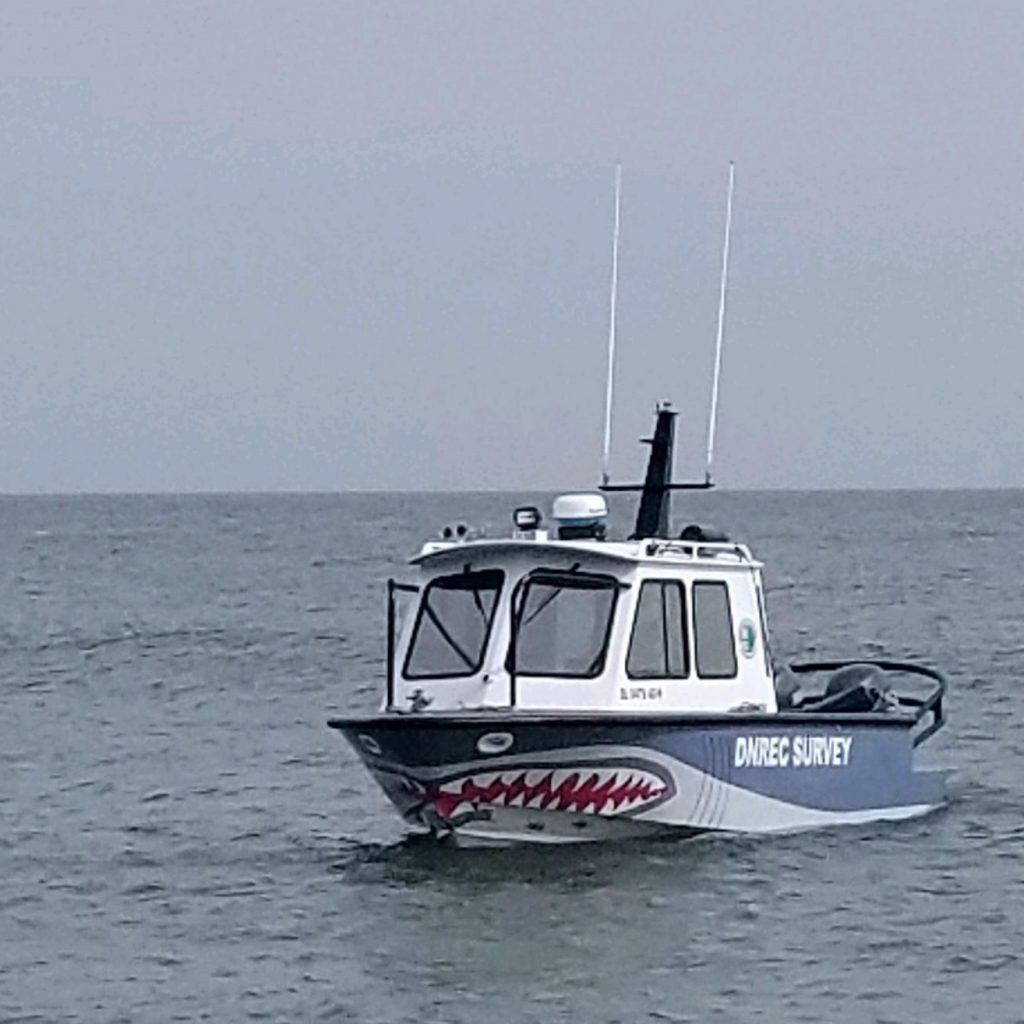
You may have seen our survey vessel and survey crew out on the water here in Delaware. This 25-foot vessel is equipped with a GPS, a sonar system to measure the depth of channels, and software used for navigation, data collection, and processing.
The sonar system on board functions like a scientific version of fish finders that you might have on your boat. The time the sound signal takes to travel from the vessel to the channel bottom and back up to the sonar’s receiver, is used to derive depth measurements. The ship’s position and motion are also incorporated and corrected for when calculating depth.
The surveys are used to determine locations to place channel markers that aid in navigation, locate and measure sediment shoals in waterways, and help with the design of dredging projects.
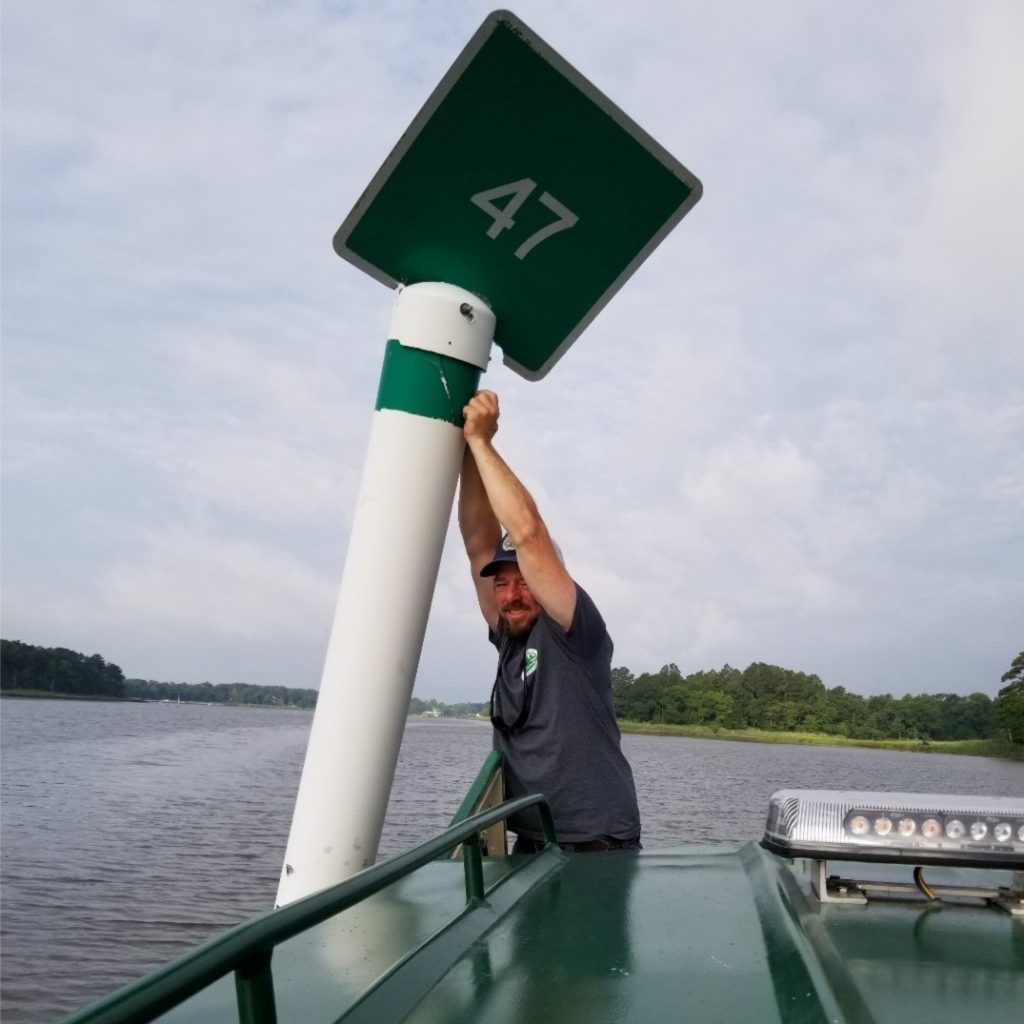
We have been marking navigational channels in Delaware’s Inland Bays since 1996. Our Section has a cooperative agreement with the United States Coast Guard to establish aids to navigation in the State’s Inland Bays channels not marked by the Coast Guard. We supplement Coast Guard markers with lighted buoys as well as PVC-pipe daybeacons.
Currently, the Section maintains almost 200 markers. Daybeacons and buoys are checked before the start of each boating season and, if needed, replaced by the Section’s channel marking crew.
Our staff on the channel marking crew are experts in working in tidal environments and using the equipment needed to place markers. We own and maintain equipment including: vessels, a hydraulic excavator, and a sectional barge – all of which are used to place the channel markers. This typically takes a 3 to 4-person team.
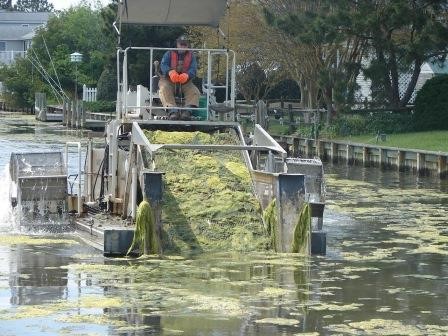
Macroalgae has become more prevalent in parts of the Inland Bays over the years as a response to increased nutrients in waterways. These nutrients come from runoff from adjacent residential and agriculture lands or domestic septic systems.
This program aims to protect, preserve, and restore natural resources in Delaware waterways by removing the excess algae growth that can become an environmental concern and cause harm.
Our Section has the capacity to operate two unique macro-algae harvesters. Harvesting helps manage large amounts of macroscopic algae located in nearshore areas. Macroscopic algae are algae you can see with the human eye, such as Ulva (or Sea lettuce).
Our Section coordinates with DNREC’s Division of Fish and Wildlife when scheduling and planning harvesting to minimize potential by-catch, such as fish, during operations.
Harvesting beneficial Submerged Aquatic Vegetation such as wigeon grass and eelgrass, is avoided because this type of growth provides good nursery habitat for aquatic species and helps to stabilize sediments.
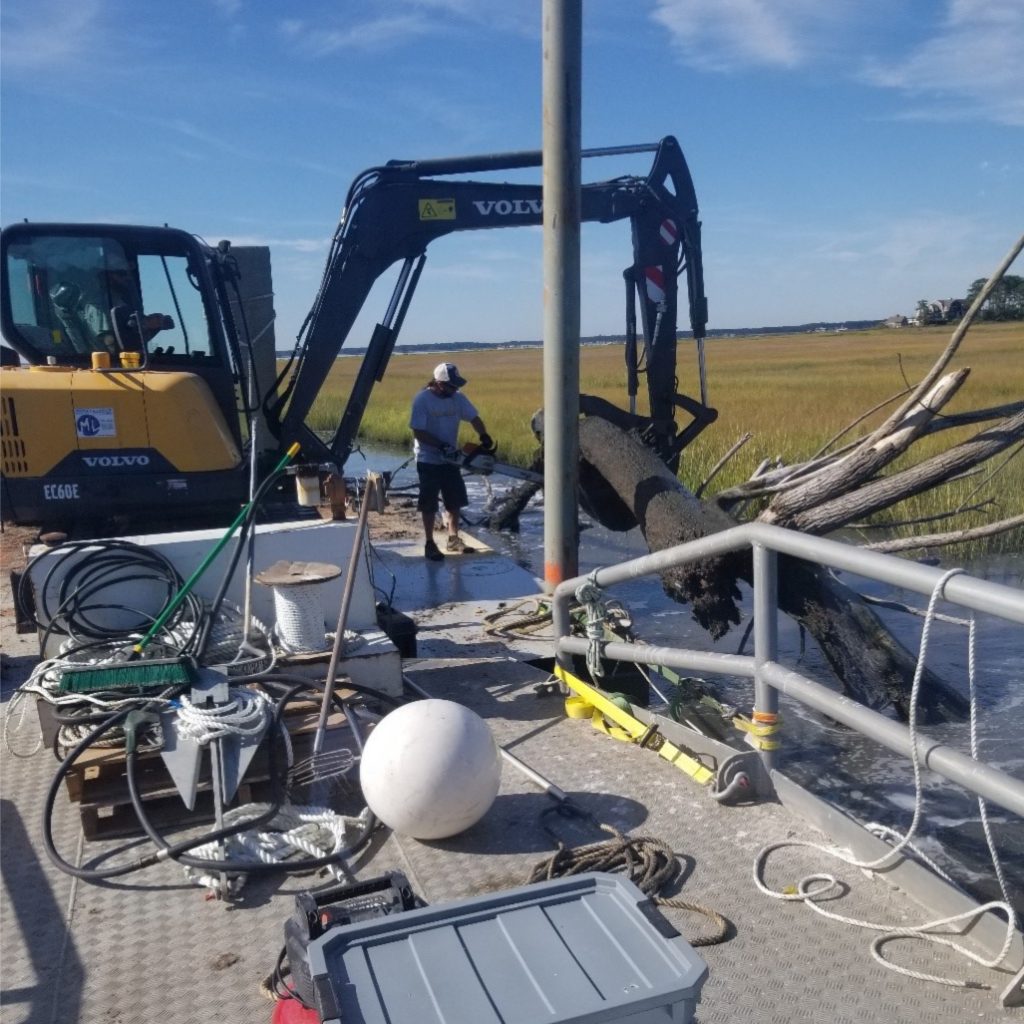
The Section owns and operates a work barge, a hydraulic excavator, and various outboard boat motors that enhance our ability to keep the state’s navigable waterways open and safe.
This equipment is used to remove abandoned vessels and derelict structures from state-maintained publicly-accessible waterways. Derelict structures might include: downed trees, ship wrecks, pilings, misplaced navigational aids, or large items of trash.
Dredging is the process of removing sediment and other material from the bottom of waterways to improve navigation. Dredging in Delaware is unique because we have a state Dredge Program that has the ability to conduct small-scale dredging operations in-house, in addition to coordinating and planning large-scale contractual operations with outside contractors.
The state currently operates two dredges that are engineered to maintain smaller waterway resources such as: channel segments, boat ramps, marinas, and state-owned lakes and ponds. In-house dredging projects include: the removal of sediment from public marina boat slips, maintaining public boat ramp depths, dredging state-owned ponds, and dredging smaller segments of channels.
Commercial dredge companies work 7 days a week around the clock and use equipment designed for removing sizeable quantities of sediment and pumping far distances for disposal. Because of this, contractual dredging is used for large-scale dredging projects in Delaware, such as the Massey’s Ditch project.
How do we decide where to dredge? We collect data and talk to our stakeholders – not only other government agencies but also the public – boaters like you! NOAA Coastal Management Fellow Sierra Davis collected a ton of data and feedback about our waterways, and has given the SWMS a way to prioritize future dredging projects. Check out her project here!
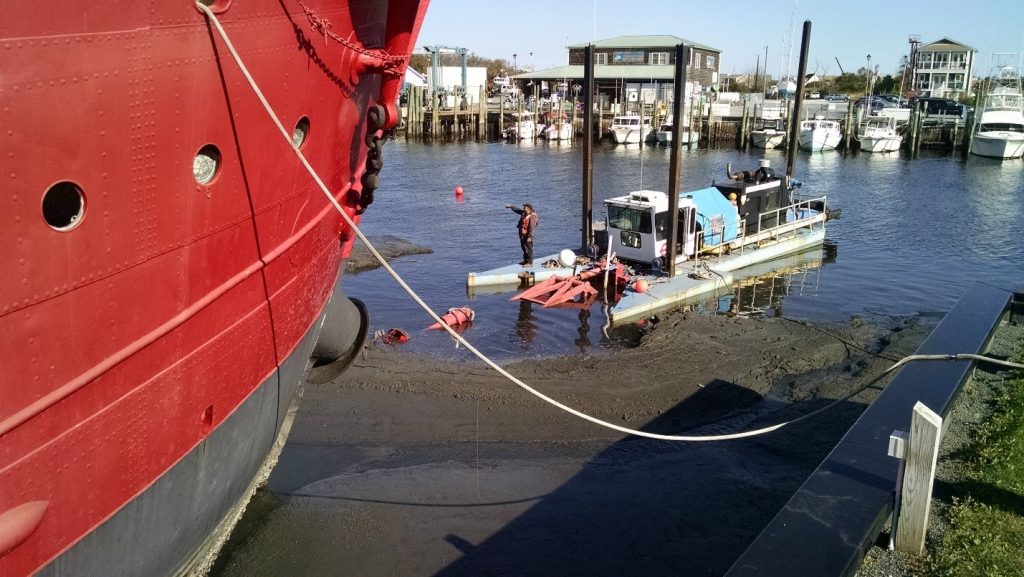
Permits are needed for dredging in Delaware. Each project must consider possible environmental effects of dredging on fisheries, water quality, and the benthic (or channel-bottom) environment.
To protect vulnerable species, dredging operations are often limited to specific months during the year. In Delaware, these environmental windows allow for dredging only in the fall and winter months. Additionally, sediment is tested before dredging begins to determine the grain size, color and presence of any contaminants to make sure that the dredging process does not stir up anything bad.
This process helps determine where sediment can be placed once dredged and that sediment can be disposed of safely. For example, if the sediment is determined to be coarse and sandy and free of contaminants, it might be beneficially used for beach nourishment.
Dredged sediment is often placed in Upland Confined Disposal Facilities (CDFs) which are diked areas of land designed to hold and safely de-water dredged sediment. The number of CDFs in Delaware has decreased over time due to facility capacity and development of upland areas as people realize the appeal of living on the water in the Inland Bays.
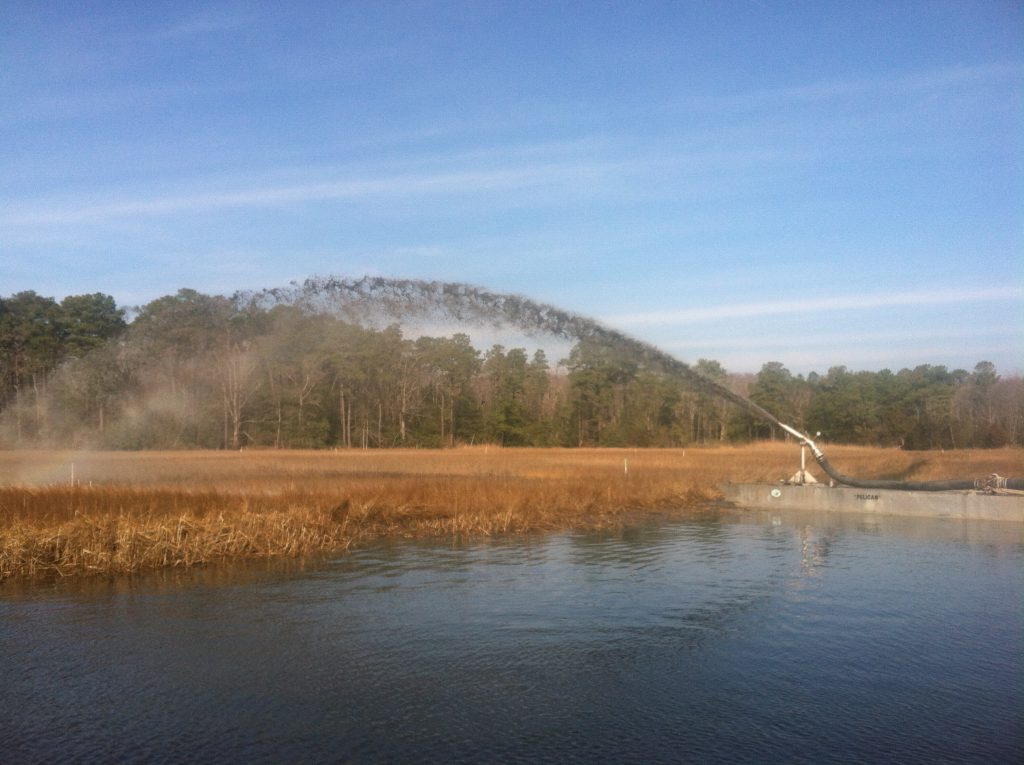
Whenever possible, it is ideal to use the sediments from a dredge project for a restoration project. Beneficial use of dredged sediment is becoming a necessary management strategy as the number of CDFs decline. Sediments themselves are also a resource and dredging practitioners such as SWMS are trying to increasingly collaborate with restoration practitioners such as WMAP to make the best use of that resource.
When dredged sediments meet certain testing standards (grain size, contaminant, color, among other testing), there can be ecological restoration opportunities that use the dredged material. These projects might include using the sediment to stabilize a shoreline, nourish a beach (such as the 2020 Massey’s Ditch project), restore an eroded marsh area, or help to protect a marsh from sea level rise (such as in the Piney Point project). With increased understanding of the environmental and restoration needs, beneficial use is regionally becoming a popular sediment management tool.
Written on: May 13th, 2020 in Outreach

Guest writer: Maggie Pletta, DNREC Division of Climate, Coastal & Energy
Delaware is known for its ability to tackle complex problems by bringing its residents together to work out solutions. Among this year’s problems: planning how the state will respond to climate change.
The impacts of climate change vary around the globe, but in Delaware, the changes we are already experiencing include increased temperatures and rising sea levels. These impacts are expected to continue or worsen. Moreover, climate scientists anticipate precipitation patterns will also change, with more frequent intense storms hitting the state. These changes will have major impacts on human health and safety, our natural resources (like wetlands), agriculture, and transportation infrastructure.
The annual average temperature in Delaware has risen 2 degrees since 1900, and the best available science projects that by 2050, the average temperature in the state will be between 2.5 and 4.5 degrees warmer than it is today. Increased temperatures directly threaten human health in a variety of ways including heat rash, heat cramps, heat exhaustion, and heat stroke. All can aggravate underlying health conditions and cause the heart, kidneys, lungs, and other internal organs to fail. But human health is not the only thing impacted by high temperature; roadways can also heave and buckle during heat waves, damaging critical infrastructure.
Records at the Lewes tide gauge indicate that sea level has risen more than a foot over the last century and are projected to rise an additional 9 to 23 inches by 2050. As sea level continues to increase a variety of impacts occur, most notably flood damage to habitats, roads, and infrastructures located in low-lying areas. Other impacts include increased erosion rates and saltwater intrusion in coastal soil and water resources that can render them unusable for agriculture and drinking water.
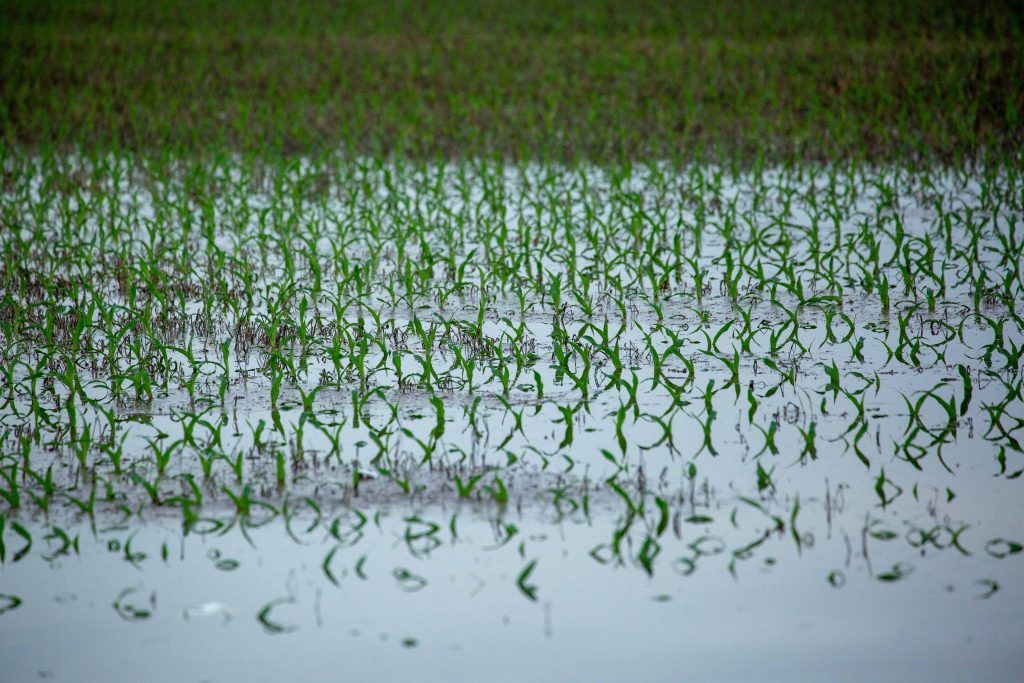
While the most recent climate trends do not show an increase in precipitation and extreme weather events, it is projected there will be noticeable changes in the future. It is projected there will be a 5% increase in average yearly precipitation and increased frequency and intensity of extreme weather events by 2050 and a 10% increase in precipitation amounts by century’s end. Changes in precipitation, including extreme rainfall events, will affect agriculture by damaging crops, altering growing seasons, and increasing crop disease pressure.
Over the course of 2020, the state is working to create the Delaware’s Climate Action Plan, a framework for how Delaware can address the causes and consequences of climate change in the decades ahead. The plan will build on years of research, plans, and commitments, such as the state’s sea level rise planning process and Delaware’s participation in the Regional Greenhouse Gas Initiative and the U.S. Climate Alliance.
The plan will map out actions to reduce greenhouse gas emissions from various economic sectors, including transportation, industry, and energy production — the three leading greenhouse gas emitters in the state.
Additionally, the plan will lay out the actions state agencies can take to support the state in adapting to climate change. These actions will be shaped by the best adaptation practices from across the world.

In developing Delaware’s Climate Action Plan, DNREC’s Division of Climate, Coastal & Energy (DCCE) hosted three public workshops in early March to learn of Delawareans’ experience with climate impacts and to gather input on how the state can best address the causes and consequences of climate change. More than 250 people attended the workshops.
The Division also held a technical advisory workshop in March with representatives from the transportation, buildings, energy, and industrial sectors to solicit ideas for reducing greenhouse gas emissions. Summary reports for the public and technical advisory workshops will be posted in the coming weeks on declimateplan.org.
DCCE’s Climate Action Plan team is continuing to shape the plan during these unprecedented times, working with technical consultants to put together a comprehensive greenhouse gas analysis that will examine which statewide strategies may be most effective in reducing the state’s carbon footprint.
The Climate Action Plan team is also actively engaging with stakeholders from across DNREC and other state agencies to identify possible adaptation actions these agencies can take as part of the final plan. These ideas for adaptation actions will be presented to the public later this year for feedback. Details on how to provide feedback will be posted online at declimateplan.org, on our Facebook and Twitter, and via the DCCE Newsletter.
For the plan to be successful, we need to hear from you, on what actions you want the state to take to address climate change.
You can provide feedback and your input in a variety of ways:
Also, be sure to follow our project website at declimateplan.org or our Facebook and Twitter pages for the most up-to-date information. With your feedback and support, we aim to create a plan that shapes a future where individuals, businesses, communities, and institutions can deal with extreme weather, harness clean energy, breathe fresh air, and live healthier lives.
Written on: May 13th, 2020 in Living Shorelines, Outreach, Wetland Restorations
Guest writer Andrew Bell, DNREC Shellfish & Recreational Water Program
At first glance, an oyster appears to be little more than, well, a bit of goo inside a rock. But actually, the humble oyster is an environmental warrior with an impressive bag of tricks up its sleeve, and it serves as a keystone species upon which depends the health of a marine ecosystem and the surrounding marsh.
Oysters provide numerous essential ecosystem services to waterbodies and wetlands.
Let’s learn more about each of these three environmental services provided by the amazing oyster.
The most obvious of the oyster’s multiple roles in Mother Nature’s army is as a water filter. Oysters eat by pumping the surrounding water through their bodies, removing from the water bits of food along with harmful excess sediments and nutrients. A single oyster can filter up to fifty gallons of water per day. Multiply that by many millions of oysters throughout an entire waterbody, and you’ve got a contaminant-gobbling army capable of filtering an entire estuary every couple days!
This filter feeding results in clearer waters which let in more sunlight, and meanwhile the depositing of oyster feces establishes a nutrient-rich seabed. This combination allows threatened seagrasses to establish beds, in turn providing habitat for marine animals such as crabs and clams. In this way, oyster reefs ultimately support the entire marine food chain.
Further, the sequestration by oysters of excess nitrogen and other nutrients prevents harmful algal blooms, which can rapidly consume all oxygen in the water and cause mass die-offs of fish and other aquatic life. Helping with this are certain bacteria that grow in the material produced by the deposition of oyster feces, which convert nitrogen into a form unusable by the algae.
Oysters are built to clean the water, and they do so at significantly lower costs than other cleanup technologies. Unfortunately, across the East Coast, the loss of oyster populations has transformed waterbodies from clear and healthy to murky and anoxic – more on that later.
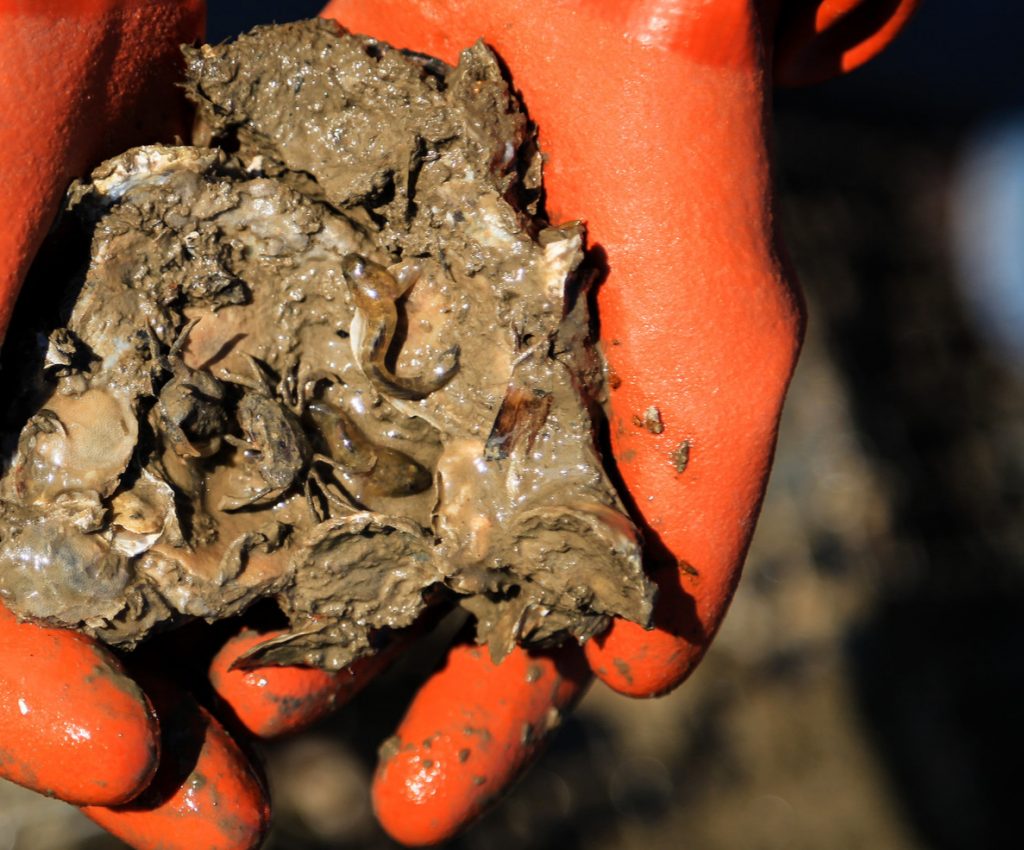
Oysters begin life as microscopic larvae that swim freely in the water before settling down on a hard surface such as rock or older shells. Now known as spat, the oysters grow into adults and fuse together into large reefs consisting of thousands of individuals. The complex three-dimensional reef structures provide essential habitat for a vast range of marine flora and fauna.
Species like mussels, barnacles, and sea anemones settle on reefs, establishing abundant food sources for fish species important to recreational and commercial harvest. Species like oyster gobies and blennies lay their eggs inside dead oyster shells to conceal them from predators. Most importantly, the innumerable nooks and crannies in an oyster reef provide shelter for marine critters, which is especially essential for juveniles in need of hiding places.
Life is not easy for baby fish and invertebrates, but oyster reefs help by buffering temperature extremes and by providing shelter from hungry predators. The presence of these organisms then attracts larger predators which in turn attract even larger predators, and in this way an oyster reef establishes its own complex and self-sustaining ecosystem. For aquatic critters, an oyster reef can be like an oasis in the middle of a desert.
Also among the many environmental benefits of the oyster is its effectiveness as a natural breakwater – in fact, it is more effective than artificial methods. Whereas artificial breakwaters like solid seawalls only deflect wave energy, potentially just passing the problem down the coast, oyster reefs dissipate the wave energy. And unlike artificial methods, an oyster reef grows and changes naturally, allowing it to keep pace with sea level rise.
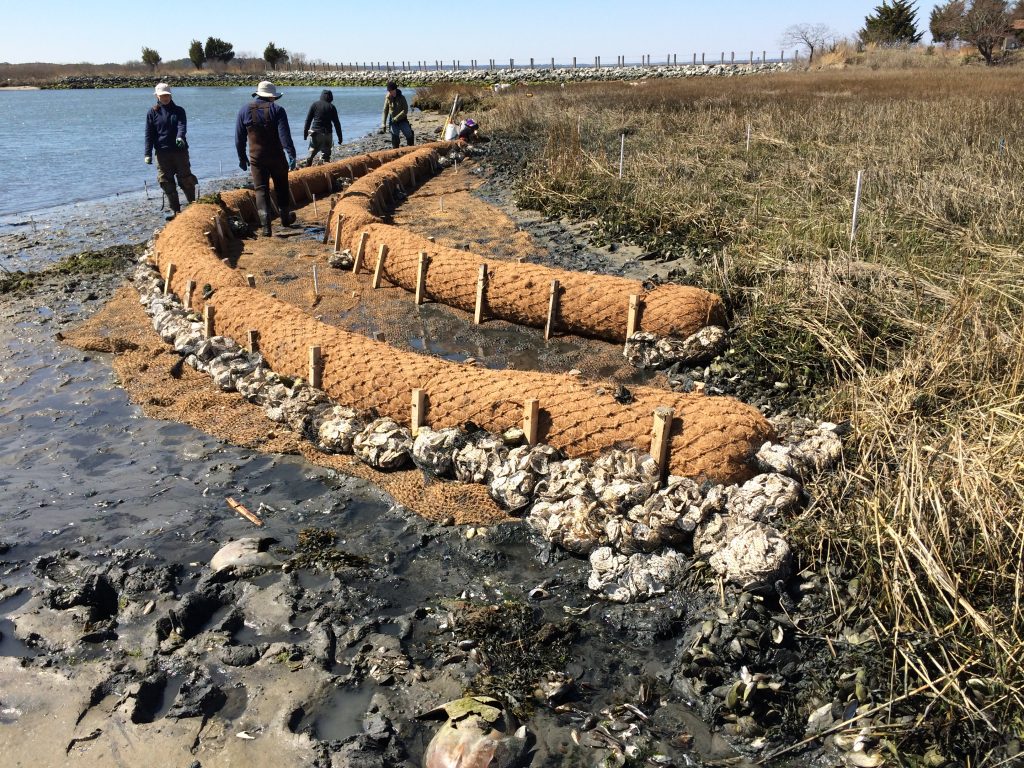
The effectiveness of a reef depends on many factors including its size and orientation, but under ideal conditions, an oyster reef will reduce up to 90% of wave energy. Oyster reefs can be especially valuable as natural breakwaters in areas where high boat traffic intensifies shoreline erosion.
The resulting calmer waters support the growth of coastal marshes and seagrass beds, which can then begin providing their own services to the ecosystem. This leads to a highly beneficial form of natural coastal and wetland protection, wherein multiple habitat types work together to maximize the benefits to the humans and animals that rely upon the coastal environment.
Oyster reefs are so essential to shoreline and wetland protection that empty shells are collected from restaurants and individuals by the Delaware Center for the Inland Bays and the Partnership for the Delaware Estuary. These organizations then stuff the shells into mesh bags that are placed along the edge of living shorelines projects. The resulting line of recycled shells then serves as the first line of defense for protecting the marsh edge from erosion by waves, and also as substrate on which new oyster reefs may form.
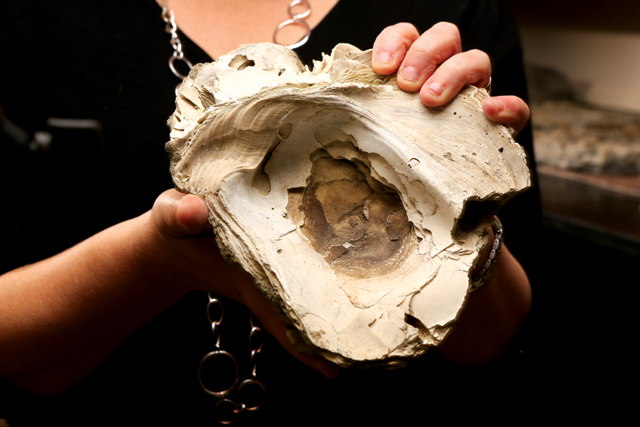
In the early 1600s, when Captain John Smith explored our region, he wrote that the oyster reefs were so numerous that the ship had to carefully navigate around them. Unfortunately, today oyster levels are at historic lows in the Delaware region and in other areas along the US coasts. By the mid-20th century, a conspiration of overharvesting, oyster diseases, and habitat degradation had devastated oyster populations, which have been having trouble recovering ever since.
Today, oyster populations are showing some hopeful signs, but the news remains mixed. As a keystone species, the devastation of oysters has resulted in waters that are murkier and more frequently anoxic, loss of important habitat, and erosion of shorelines and marsh.
Fortunately, just as the loss of oysters results in great harm to other species, the reintroduction of oysters can help those species recover. Oyster restoration is a top priority of many environmental organizations because the ecosystem services provided by oysters are so significant, varied, and long-lasting. Not to mention, oyster restoration efforts are often more cost-effective and technologically simpler than other types of projects.
Last year, the first oysters grown in the Inland Bay’s new shellfish aquaculture program were harvested and enjoyed at Delaware restaurants. Rather than being harvested from wild reefs, these oysters are grown from seed in cages. Oyster farmers lease acres of the Inland Bays from the State of Delaware, then tend to the oysters as they grow from seed the size of small pebbles to adult oysters that are then enjoyed in raw bars in Delaware and beyond.
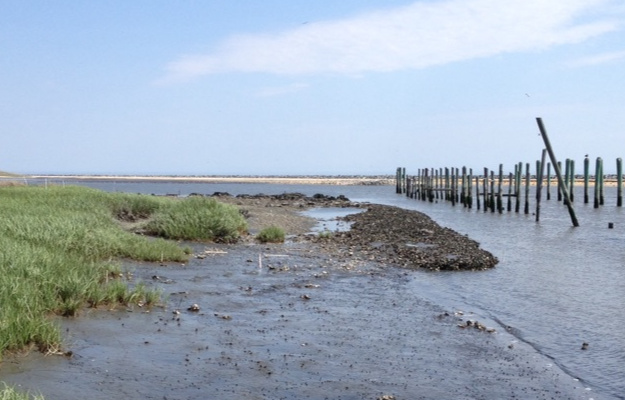
Oyster farming is sustainable, benefitting the ecosystem by replicating the environmental services once provided by great natural oyster reefs. They filter the water of the Inland Bays, which have long suffered from excess levels of nutrients and sediments that are preventing remnant seagrass beds from expanding. They provide three-dimensional structure, transforming the flat, featureless bottom typical of the Inland Bays into complex habitat that attracts a variety of important and threatened species. In this way, they serve as replacement habitat for the seagrass beds that were once ubiquitous in bays up and down the coast, and oyster farmers have been amazed at the huge variety of critters they find in and around their cages. And the aquacultured oysters help reduce the marsh erosion, important considering the high boat traffic common in the Inland Bays.
Oyster farmers take great care to keep their products safe for enjoyment by healthy consumers. As oysters filter feed, they remove not only food particles from the water, but also naturally-occurring pathogens, which are then concentrated at rates higher than the surrounding water. As a consequence, persons with certain medical conditions should never consume oysters unless thoroughly cooked, but raw oysters are nutritious and delicious for healthy persons. DNREC works with oyster farmers to enforce regulations for shellfish harvesting and handling to prevent shellfish-borne illness.
It is hoped that the new oyster aquaculture program, along with oyster restoration efforts being spearheaded by several organizations, will help restore our state waters and wetlands through the oyster’s tremendous capacity for filtering water, providing habitat, and preventing shoreline erosion. Truly, oysters are amazing environmental warriors with a keystone role in ensuring that ecosystems stay healthy for the benefit of a range of plants and animals which includes, of course, you and me!